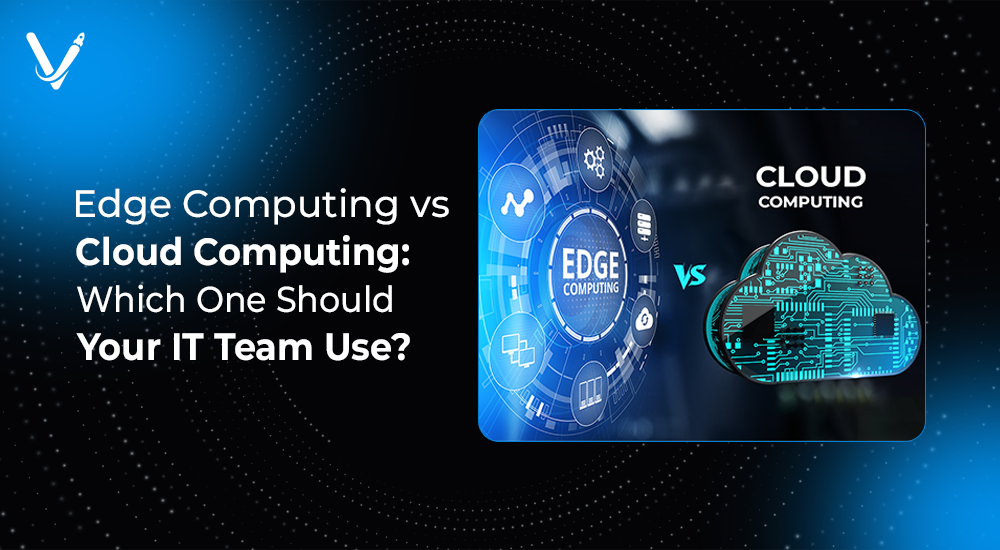Edge Computing vs Cloud Computing: Which One Should Your IT Team Use?


- Jul 26, 2025



As digital experiences become more dynamic, connected, and real-time, businesses are facing a critical infrastructure choice: edge computing or cloud computing. Each model offers unique benefits and trade-offs, and the right choice can drastically impact speed, scalability, data privacy, and cost efficiency.
In 2025, organizations are managing increasingly complex systems—from AI-driven applications and IoT networks to real-time analytics and immersive AR/VR experiences. The stakes are high, and choosing the wrong architecture can lead to performance bottlenecks, inflated costs, and unsatisfied users.
This article dives deep into edge computing vs cloud computing, clarifying their differences, highlighting when and why to use each, and providing actionable guidance to help your IT team make the smartest choice for your business.
Cloud computing refers to the delivery of computing services—servers, storage, databases, networking, software, and more—over the internet (“the cloud”). These resources are hosted in centralized data centers owned by providers like Amazon Web Services (AWS), Microsoft Azure, and Google Cloud Platform.
Cloud computing has revolutionized IT operations by reducing the need for on-premises hardware, enabling global collaboration, and allowing startups to scale without heavy CapEx investment.
Edge computing shifts data processing closer to the physical location where data is generated—“the edge” of the network. This could be a factory floor, a smart car, a retail store, or a 5G tower. Instead of sending data to a distant cloud server, it is processed locally in real time.
Edge computing complements cloud computing and is especially vital for applications requiring ultra-fast response times and context-aware computing.
SaaS Applications
Cloud is the backbone of platforms like Salesforce, Dropbox, and Google Workspace—where users need global access and consistent availability.
Big Data Analytics
Centralized cloud platforms can handle massive datasets, ideal for AI model training, customer insights, and financial forecasting.
Remote Work Infrastructure
Cloud-native tools like Microsoft Teams and Zoom enable seamless collaboration across regions and devices.
Case Study: Netflix
Netflix uses AWS to handle content delivery, recommendation algorithms, user data analysis, and scalability during traffic spikes.
Industrial IoT and Smart Factories
Manufacturing systems use edge devices to monitor machine health and prevent breakdowns in real-time.
Autonomous Vehicles
Self-driving cars require edge processing for real-time decisions—waiting for the cloud could be fatal.
Smart Retail
Retailers like Amazon Go use edge computing for instant customer recognition, shelf monitoring, and checkout-free shopping.
Healthcare Monitoring
Edge-enabled medical devices can analyze patient vitals locally and only send critical alerts to the cloud.
Case Study: Tesla
Tesla vehicles use edge computing to process data from sensors and cameras instantly for navigation and safety.
| Metric | Cloud Computing | Edge Computing |
| Average Latency | 50–100 ms | <10 ms |
| Ideal for | Global apps, storage | Real-time processing |
| Bandwidth Usage | High | Lower (filtered locally) |
| Offline Capability | Limited | High |
| Data Privacy Control | Moderate | High |
| Maintenance Overhead | Lower | Higher |
With the widespread rollout of 5G, edge computing is becoming more feasible, enabling near-instant communication between edge nodes and devices.
By 2025, over 75 billion IoT devices will be in use, generating zettabytes of data. Edge computing ensures that these devices can act on insights in real time.
AI models are increasingly being deployed on edge devices, allowing instant decision-making without relying on cloud-based inference.
Example: Smart security cameras using onboard AI to detect intrusions and only upload suspicious clips to the cloud.
Insight: According to Gartner, organizations can save up to 30% in bandwidth and cloud storage costs by offloading routine data processing to edge devices.
Retail:
Walmart uses edge computing for in-store inventory and sensor data, while using cloud for eCommerce operations and analytics.
Healthcare:
Hospitals process imaging data at the edge for quick diagnosis and sync with cloud platforms like Google Cloud for deeper analysis.
Agriculture:
Edge devices in smart farms analyze soil conditions and trigger irrigation, while cloud analytics optimize crop cycles at scale.
Gaming:
Cloud gaming platforms (e.g., Xbox Cloud Gaming) rely on the cloud, but edge servers are placed closer to users for low-lag experiences.
Edge computing will not replace the cloud—it will extend it. The future of IT infrastructure lies in intelligent distribution. Enterprises will optimize workloads dynamically, deploying real-time, latency-sensitive functions at the edge while relying on the cloud for storage, compliance, and global orchestration.
The rise of AI-powered orchestration tools, edge-native development frameworks, and cloud-edge mesh networks will further streamline the hybrid approach.
By 2027, over 50% of enterprise-generated data will be created and processed outside of centralized cloud data centers (Gartner), signaling a fundamental shift in how infrastructure is architected.
Edge computing and cloud computing are not rivals—they are tools in the modern IT toolbox. Understanding their strengths and limitations is crucial for building high-performance, scalable, and secure systems.
If your application requires speed, privacy, and offline capability, go edge.
If your business demands scale, accessibility, and flexibility, stick with cloud.
If you want the best of both worlds—combine them intelligently.
Your IT team’s decision should be guided by use cases, user experience requirements, budget, and future scalability.
At Vasundhara Infotech, we help organizations architect the right mix of edge and cloud technologies tailored to their unique needs. Whether you're building real-time IoT solutions or planning scalable cloud infrastructure, our experts are here to guide you.
Ready to accelerate innovation with the right infrastructure?
Contact us today for a strategic consultation on edge vs cloud solutions.
Copyright © 2026 Vasundhara Infotech. All Rights Reserved.